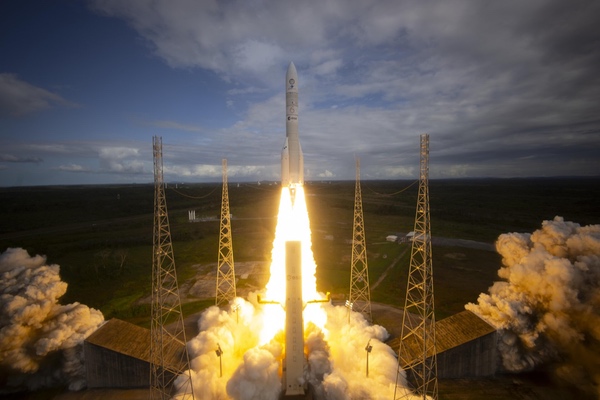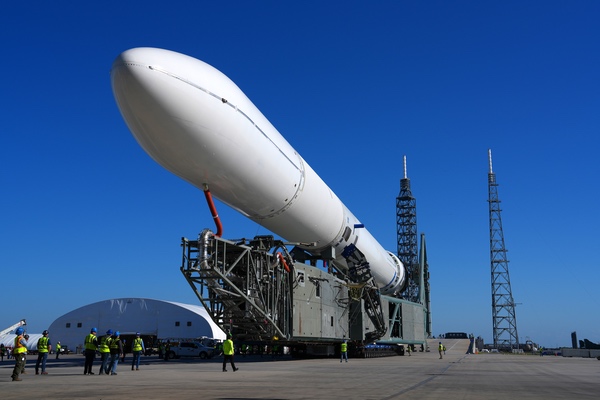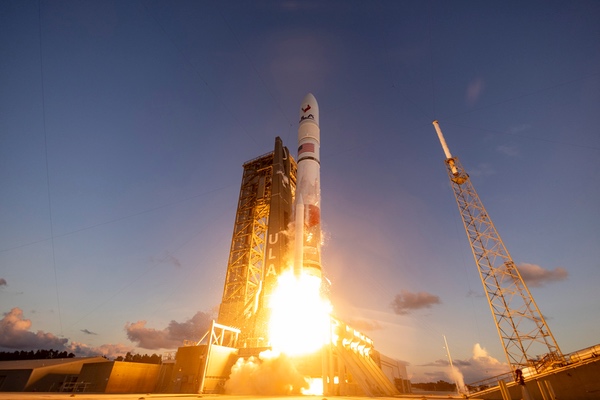Gaining confidence in new launch vehiclesby Jeff Foust
|
| “Yes, it looks dramatic, like all things on a rocket,” Bruno said of the SRB anomaly. “But, it’s just the release of the nozzle. No explosions occurred.” |
That confidence was tested about 35 seconds after liftoff on Friday, October 4. A shower of material came off one of the two GEM 63XL solid rocket boosters (SRBs) attached to the first stage. The video of the launch showed the rocket appearing to deviate, ever so slightly, from its trajectory before correcting itself.
Vulcan, though, continued to ascend, with the timing of some key events like SRB separation and, later, separation of the first and second stages, a handful of seconds behind the published timeline. After two burns of the Centaur upper stage, ULA declared the mission a success.
“We did have an observation on SRB number one, and so we will be off looking into that after the mission is complete,” Bruno said on the launch webcast after the completion of the second Centaur burn. “Other than that, the flight was nominal.”
In later postings on social media, Bruno stated that the nozzle on that SRB came off, but that there was no damage to the motor itself, which continued to burn. “Yes, it looks dramatic, like all things on a rocket,” he wrote. “But, it’s just the release of the nozzle. No explosions occurred.”
It was not clear how it would affect the key purpose for carrying out the Cert-2 mission: certification of the rocket by the US Space Force for carrying national security missions. In a statement, the Space Force’s Space Systems Command made no mention of the SRB “observation” and offered only general comments about the launch.
“We are already starting to review the performance data from this launch, and we look forward to Vulcan meeting the certification requirements for a range of National Security Space missions,” said Brig. Gen. Kristin Panzenhagen, the program executive officer for assured access to space at the command.
The Cert-2 mission, and the certification it would enable, was so important to ULA that it flew the launch without a paying customer. Originally, the second Vulcan mission was going to loft Sierra Space’s Dream Chaser uncrewed spaceplane on its inaugural flight. In June, though, ULA said it would move forward with the launch without Dream Chaser after Sierra Space said the vehicle would not be ready for a launch in the fall, the schedule ULA was trying to hold.
Bruno said last week that ULA waited as long as it could, so long that there was no time to fly any other customer on Cert-2 once Sierra Space concluded it would not be ready. Instead, ULA flew a mass simulator that it developed had the payload for the earlier Cert-1 mission, Astrobotic’s Peregrine lunar lander, not been ready. He said ULA absorbed the cost of the launch, which he estimated to be in the “high tens of millions of dollars,” to keep Cert-2 on schedule.
That schedule was important because ULA wants the certification from the Space Force in time to launch two national security missions before the end of the year. One, USSF-106, will launch Navigation Technology Satellite 3, a technology demonstration mission. The other, USSF-87, is carrying a classified payload.
Bruno said in the pre-launch briefing that ULA was already starting to prepare the Vulcan for the first of two missions, getting as much work done as possible while awaiting certification. He deferred to the Space Force on how long the certification process would take—Panzenhagen, at a conference in September, would only say that it would take “some time”—but said ULA would work to get the data from the mission to the Space Force for its review in a matter of weeks.
While there was no paying customer for the mission, ULA made the most of the test flight. In addition to the mass simulator, the company instrumented the upper stage and planned experiments using it, concluding with a third and final burn of the Centaur that would place the stage into a heliocentric orbit.
Those experiments, he said, were linked to future plans for a “high-performance, long-duration” version of the Centaur. That version would be able to operate for days or weeks, versus hours of the current version, with features intended to minimize boiloff of its cryogenic liquid oxygen and liquid hydrogen payloads as well as limiting the use of consumables like hydrazine used for maneuvering thrusters.
That would, Bruno argued, turn Centaur into something of a space tug, something ULA studied years ago as the Advanced Cryogenic Evolved Stage (ACES) but later set aside. “What that would allow us to do is to have an in-space transportation capability for in-space mobility and servicing and things like that,” he said. “It’s a pretty revolutionary capability if you can have that.”
ULA is also continuing to study what it calls Sensible, Modular, Autonomous Return Technology (SMART) reuse. That would return only the engine section, rather than the entire first stage, using an inflatable hypersonic decelerator heat shield like what NASA tested with the Low-Earth Orbit Flight Test of an Inflatable Decelerator (LOFTID) tech demo mission two years ago.
Bruno said at the briefing that ULA completed a preliminary design review of SMART reuse at the beginning of the year and is now doing component testing ahead of a critical design review at the end of the year.
| “What that would allow us to do is to have an in-space transportation capability for in-space mobility and servicing and things like that,” Bruno said of a long-duration Centaur. |
“We would be probably another, I’d say, one to two years away from the first flight” after the critical design review. That first flight would be just to test separating the engine section. “We’re just going to let it fall in the ocean.” Subsequent tests would test the hypersonic decelerator and parachutes to see if the engines can splash down safely and what condition the BE-4 engines are in, followed eventually by reuse of the engines.
That activity comes as ULA works to ramp up its launch rate. The Cert-2 mission was just the fifth launch ULA did in 2025, including two Atlas flights and the final launch of the Delta 4 Heavy. However, Bruno said ULA plans to do as many as 20 launches in 2025, split roughly evenly between the Atlas and Vulcan.
That manifest includes national security payloads as well as launches of satellites for Amazon’s Project Kuiper constellation. He said ULA is also saving room for Dream Chaser after it lost its slot on Cert-2. “It’s just a matter of when they’re ready to go,” he said.
 The first Ariane 6 lifts off July 9 from French Guiana. (credit: ESA/S. Corvaja ) |
Ariane 6 ramps up
While Vulcan now has two launches in the book, another new launch vehicle is gearing up for its second flight. In July, Europe’s Ariane 6 made its long-awaited, long-delayed debut. Getting the vehicle off the pad and into orbit was cause for celebration among space agency and industry officials, ending a “launcher crisis” that effectively deprived Europe of independent access to space since the Ariane 5 retired a year earlier.
“You can imagine,” said ESA director general Josef Aschbacher at the Farnborough International Airshow a couple weeks after the launch, “how important this success was for all of us. For ESA, for space in Europe, it was really huge.”
The launch, though, was not a complete success. The upper stage’s Vinci engine failed to perform a final burn, which stranded the upper stage in orbit rather than deorbiting it. It also kept two reentry demonstrator payloads on the stage, one from launch vehicle prime contractor ArianeGroup and the other by startup The Exploration Company, from carrying out their missions.
The Ariane 6 “task force,” which includes ESA and ArianeGroup as well as French space agency CNES and launch services provider Arianespace, investigated the failed engine restart. They noted initially that the issue did not need to be corrected for the second Ariane 6 mission, scheduled for the end of this year, since the upper stage does not need to perform multiple burns to deploy its payload, the French CSO-3 reconnaissance satellite.
| “We are not going to introduce on the market more than nine to ten [per year] in the coming years,” Israël said of Ariane 6 launch rates. |
Last month, the task force said they found the root cause: the auxiliary propulsion unit (APU) on the upper stage failed to start when a temperature reading was out of limits, which kept the Vinci engine from firing. The task force said a software fix for the APU should correct the problem for future launches.
That software fix will be implemented ahead of the second launch. “We could have done the second flight without correcting it,” said Stéphane Israël, CEO of Arianespace, at a briefing in Paris on the sidelines of the World Space Business Week conference. “But we want to deorbit the second stage during this second flight, and to deorbit the upper stage we need to correct what has happened.”
His company wants to quickly ramp up Ariane 6’s launch rate as it works through a backlog of nearly 30 launches, including 18 for Project Kuiper. Arianespace is projecting six Ariane 6 launches next year and, by 2027, getting to a steady-state launch rate of nine or ten launches a year.
However, he said there are no plans to go higher than that annual rate, which is similar to the typical monthly launch rate for SpaceX’s Falcon 9 this year. He cited a bottleneck of production of SRBs for the Ariane 6: each launch uses two or four such boosters.
“If we were to increase the cadence, we would have to invest a lot” to build up production of those SRBs, he said. He sounded skeptical that there would be sufficient demand to make that investment pay off. “We are not going to introduce on the market more than nine to ten in the coming years.”
 A New Glenn vehicle rolled out to the pad at Launch Complex 36 early this year for tests. (credit: Blue Origin) |
Awaiting New Glenn
Yet another new launch vehicle still has not made its debut, but is coming close. Blue Origin says it has been making progress on its New Glenn rocket, including a static-fire test last month of the upper stage of the first flight model of the rocket’s upper stage. The stage’s two BE-3U engines—derivatives of the engine used on the company’s New Shepard suborbital vehicle—fired for 15 seconds in the test at Cape Canaveral’s Launch Complex 36.
Blue Origin had been planning to launch on the inaugural New Glenn a NASA smallsat mission called Escape and Plasma Acceleration and Dynamics Explorers, or ESCAPADE. The twin ESCAPADE satellites, built by Rocket Lab and weighing just over half a ton each, would go to Mars to study the interaction of the solar wind with the planet’s weak magnetic field.
That required launching the mission during a narrow window in mid-October: between the 13th and 21st. That was asking a lot for the first launch of a new rocket, particularly one that had, like Vulcan and Ariane 6, also suffered its share of delays. But both Blue Origin and NASA continued to work towards a launch in October.
Until, on September 6, NASA announced it decided not to fly ESCPADE on New Glenn in October. The decision, the agency said, came ahead of a milestone where the spacecraft would have been loaded with hydrazine and nitrogen tetroxide propellants, a step that is difficult, and expensive, to reverse.
“The decision was made to avoid significant cost, schedule, and technical challenges associated with potentially removing fuel from the spacecraft in the event of a launch delay, which could be caused by a number of factors,” NASA stated.
That decision appears to have been a wise one. At the time of NASA’s announcement, on a Friday, an industry source said Blue Origin has been preparing for a test-firing of the upper stage the following Monday, a schedule that would keep a mid-October launch on track. That test slipped by two weeks, though.
| “For this first launch, I have two primary objectives: get to orbit and land the booster,” Jones said of New Glenn’s debut. |
That inaugural New Glenn launch, designated NG-1 by Blue Origin, will instead carry technologies to be tested for the company’s Blue Ring orbital transfer vehicle. That launch could take place as soon as early November, the company said. ESCPADE could instead fly on another New Glenn as soon as the spring of 2025, although neither NASA nor Blue Origin have provided details on the trajectory that would allow ESCAPADE to reach Mars outside of the traditional launch windows that open roughly every two years, and are next available in late 2026.
Blue Origin, like Arianespace and ULA, has ambitious plans to scale up launches to meet the needs of their customers: all three have as a customer Amazon’s Project Kuiper, which is facing FCC deadlines in mid-2026 to deploy at least half of its 3,600-satellite constellation.
Jarrett Jones, senior vice president for New Glenn at Blue Origin, said on a panel at World Space Business Week that the company will have the capacity to perform up to 12 launches in 2025, although he suggested eight to ten was more likely. “But then, for 2026, we go straight into 24 launches.”
That depends on demonstrating the ability to land and reuse New Glenn’s first stage. Unlike SpaceX, which experimented with landing—often with explosive results—before making such landings routine, Blue Origin is counting on landing the booster on the very first flight.
“For this first launch, I have two primary objectives: get to orbit and land the booster,” Jones said. “It’s super-critical because we have to get that down pat and then get our reusability and then get to rate. We can’t wait on it in 2025.”
Blue Origin CEO Dave Limp posted a picture of the booster on social media and noted that the booster has a name: “So You’re Telling Me There’s a Chance,” a reference from the movie Dumb and Dumber (where the character speaking that line had, in fact, very little chance.)
“No one has landed a reusable booster on the first try. Yet, we’re going for it, and humbly submit having good confidence in landing it,” he wrote. But as Cert-2 showed, even the confident can run into problems.
Note: we are now moderating comments. There will be a delay in posting comments and no guarantee that all submitted comments will be posted.
